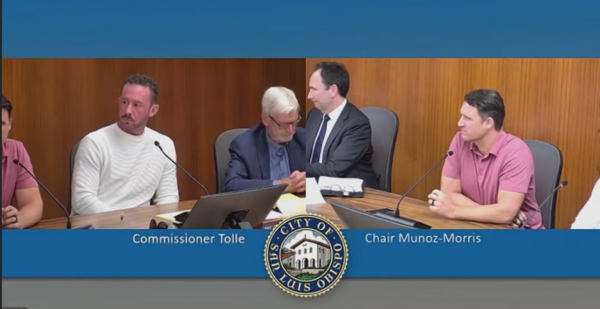San Luis Obispo drops plan for homeless parking, unsure about future plans
September 7, 2023

San Luis Obispo Planning Commission
By KAREN VELIE
The city of San Luis Obispo and a nonprofit dropped plans on Wednesday to provide an overnight parking area for homeless people on Palm Street near the Veterans Memorial Building after neighbors raised procedural, safety and legal concerns.
The plan was to move the safe parking program from faith base facilities to public areas monthly with Community Action Partnership of San Luis Obispo County (CAPSLO) managing the sites. The city recently closed its Railroad Square safe parking area.
Neighbors then voiced concerns regarding transparency and neighborhood safety, which caused the city to delay its plan to close a portion of Palm Street and temporarily transform the area into a safe parking area. However, after a neighbor provided the city with case law which appears to show the plan is not legal, the city dropped its Palm Street proposal.
During a SLO Planning Commission meeting on Wednesday night, residents chastised the city for failing to inform neighbors in the Palm Street area and to protect businesses and the community near their safe parking areas.
“I am in favor of offering services to help the unhoused,” Lynn Hamilton said. “However the city’s poor planning and management has led to the complete shutdown of safe parking services. The city and CAPSLO have been disingenuous about the success of the Railroad Services program. Police records show that 123 calls were made since 0ct 2021. Why the city thinks CAPSLO can run the safe parking program is beyond me.”
Multiple speakers, both homeless and neighbors, questioned the quality of CAPSLO’s management, which brags of a 14% rate of moving the unhoused living in cars into homes. About 26% of SLO’s approximately 385 homeless people sleep in cars.
A recent SLO County Grand Jury found that CAPSLO has been unsuccessful at helping the majority of its participant households successfully transition to permanent housing. With a transition rate of 14%, the county safe parking site falls well below the median rehousing rate of 40% found in a 2021 nationwide study of 43 safe parking programs, according to the grand jury report.
In addition, the Grand Jury determined CAPSLO had failed to accomplish tasks they were paid to perform at the county’s safe parking site on Oklahoma Avenue and then refused to provide the Grand Jury records.
Commissioners said they hope the city comes back to them with a resolution in the near future in order to do something for the homeless. In addition, commissioners said they need to look into CAPSLO’s management and ways to improve the safe parking program while keeping residents safe.






The comments below represent the opinion of the writer and do not represent the views or policies of CalCoastNews.com. Please address the Policies, events and arguments, not the person. Constructive debate is good; mockery, taunting, and name calling is not. Comment Guidelines